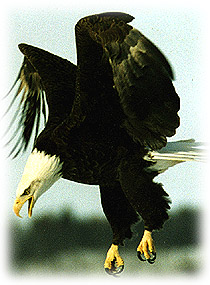The bald eagle lives near the Hudson River.


The bald eagle is not bald! Its head is covered with white feathers. Its tail is covered with white feathers, too.
For locomotion, the bald eagle uses its wings. Its wing span is 7 feet. That is taller than most humans!
The bald eagle has adapted to its habitat by developing predatory talons. Predatory talons are its long, strong, and sharp claws. These talons allow the bald eagle to easily swoop down and capture its prey. The bald eagle is a predator.
The bald eagle's habitat is always near water. There are two different groups of eagles that live along the Hudson River. One group of bald eagles comes from the north. They spend the winter along the Hudson River. The second group of bald eagles has made the Hudson River their year-round habitat.
The bald eagle's diet is mostly made up of fish and food that it steals from other animals. When the bald eagle hunts, it uses its predatory talons to swoop down and capture fish out of the Hudson River. The bald eagle will sometimes hunt and eat small mammals, too.
Some of the fish that the bald eagle eats have been poisoned by pollution in the Hudson River. The pollution in the fish that the bald eagle eats can cause the bald eagle to become sick or even die. Thirty years ago, many of the bald eagles who lived near the Hudson River died because of the pollution. The United States government decided to protect them better so that the bald eagle would not become extinct. There are a lot more bald eagles living around the Hudson River than there were 30 years ago because of the United States government.
The bald eagle's habitat is always near _________?
 |
Animal |
 |